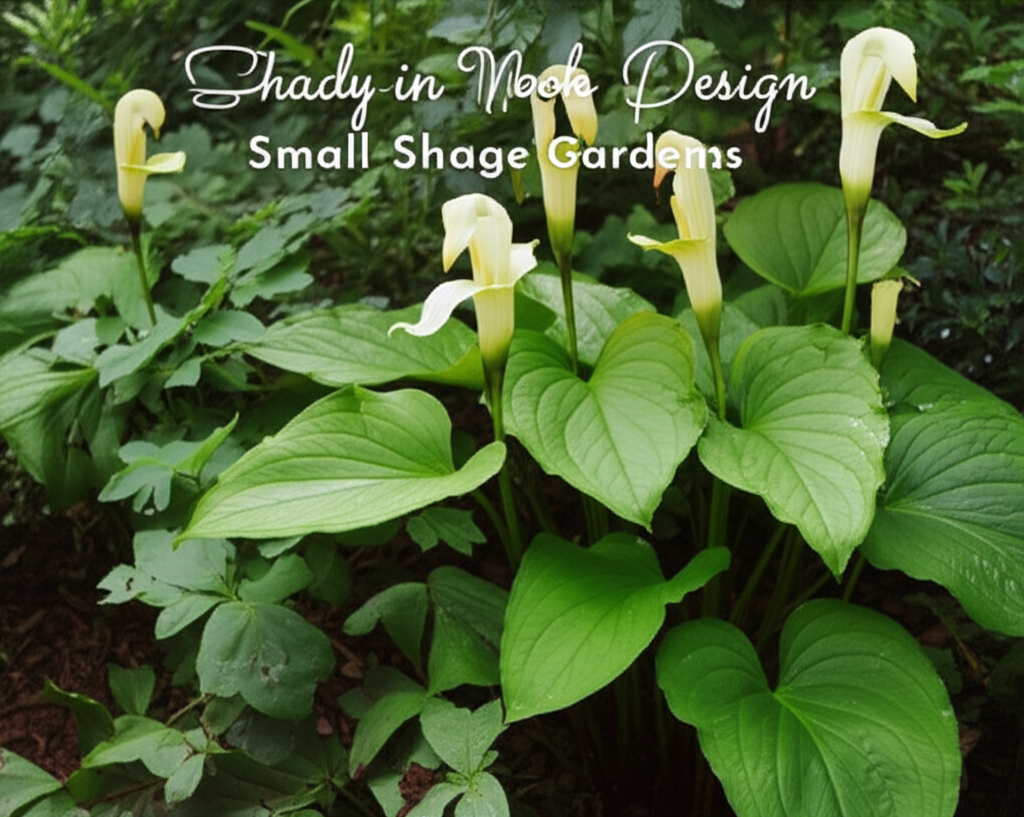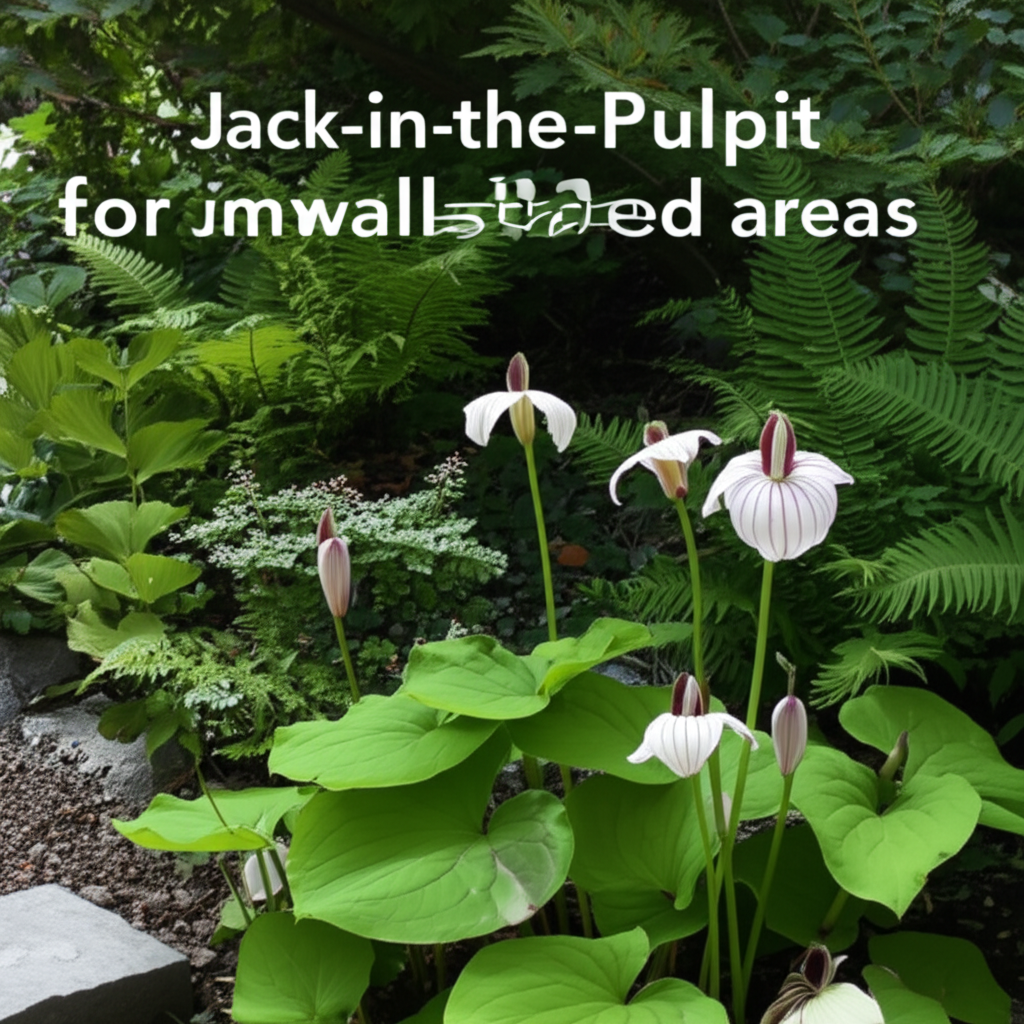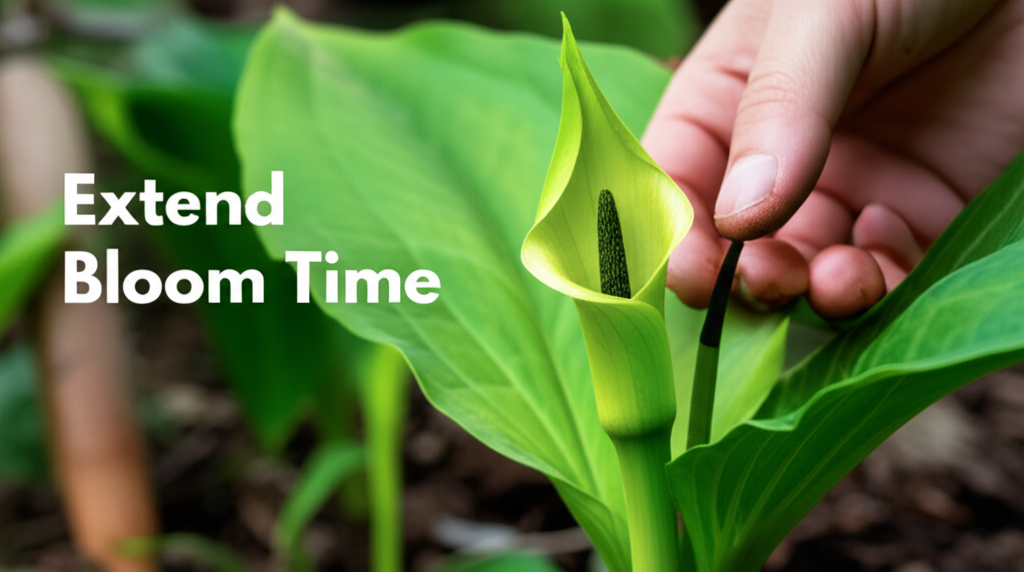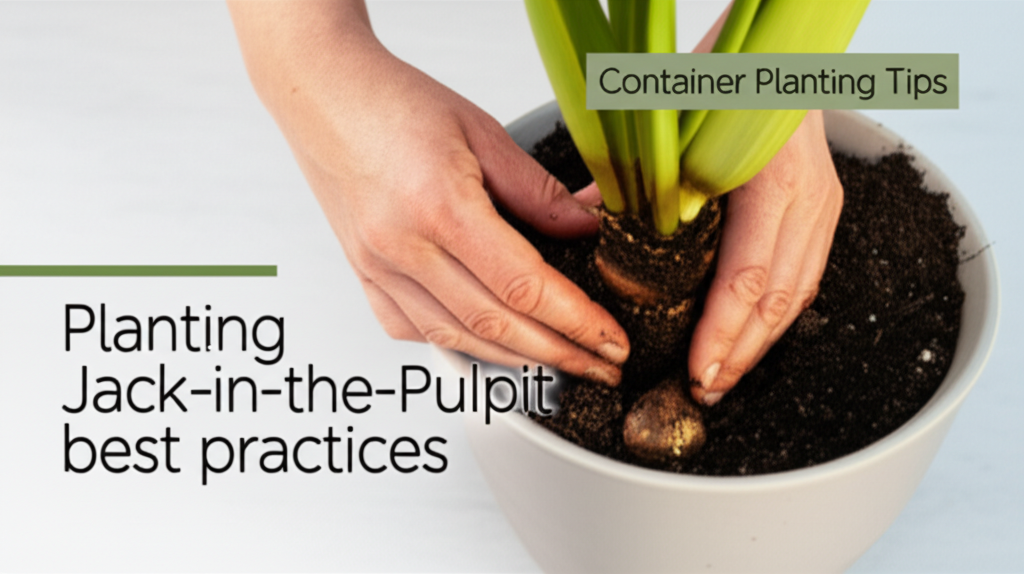Embracing the Shade: Why Jack-in-the-Pulpit is Ideal for Small Gardens
Many gardeners dream of lush, vibrant outdoor spaces, but the reality for a significant number is limited sunlight. Small backyards, urban balconies, or areas perpetually under the canopy of mature trees often present a challenge for sun-loving plants. However, these shaded nooks are precisely where the enchanting Jack-in-the-Pulpit (Arisaema triphyllum) truly shines. This native woodland perennial is a master of dappled light, bringing a unique architectural beauty and intriguing bloom to even the most compact of shady gardens.
Its distinctive spathe and spadix, resembling a preacher in a pulpit, are not just a curiosity; they are a testament to the plant’s evolutionary adaptations to the forest floor. This captivating visual, coupled with its relatively small stature and a preference for moist, well-drained soil, makes Jack-in-the-Pulpit an exceptional choice for small shaded garden designs. It offers a touch of the wild and whimsical without demanding ample space or direct sun, transforming overlooked corners into miniature woodland wonders.
Understanding Jack-in-the-Pulpit: Biology and Appeal
Before diving into garden design, it’s crucial to understand what makes this plant so special. Jack-in-the-Pulpit is a herbaceous perennial native to eastern North America. It thrives in woodlands, damp meadows, and along stream banks, conditions that are replicated in many shady garden spots.
The plant’s most striking feature is its inflorescence. The “jack” is the spadix, a fleshy spike bearing tiny flowers, and the “pulpit” is the spathe, a hooded leaf-like structure that partially encloses the spadix. The spathe can vary in color, from deep green to mottled purple or brown, often with stripes. After flowering, Jack-in-the-Pulpit develops attractive clusters of bright red berries, which add further visual interest in late summer and autumn.
Key Facts and Comparison with Other Shade-Tolerant Plants
Here’s a look at some key characteristics of Jack-in-the-Pulpit and how it compares to other popular shade-loving plants often considered for small gardens.
| Feature | Jack-in-the-Pulpit (Arisaema triphyllum) | Hostas | Ferns (e.g., Ostrich Fern) | Astilbe |
|---|---|---|---|---|
| Light Requirement | Partial to full shade; dappled sunlight | Partial to full shade | Partial to full shade | Partial shade; some varieties tolerate more sun with consistent moisture |
| Mature Size (Height) | 1-3 feet | 6 inches – 4 feet (depending on variety) | 1-5 feet (depending on variety) | 1-4 feet |
| Bloom Time | Late spring to early summer | Summer (often inconspicuous flowers) | Primarily foliage interest | Summer |
| Foliage Interest | Attractive, compound leaves; dramatic spring bloom; red berries in fall | Excellent foliage texture and color; vast variety | Lush, feathery fronds; diverse textures | Attractive, fern-like foliage; feathery plumes |
| Soil Preference | Moist, rich, well-drained, slightly acidic | Moist, well-drained, adaptable | Moist, organic-rich | Moist, rich, well-drained |
| Unique Feature | Iconic “jack” and “pulpit” bloom structure; edible corms (properly prepared) | Wide range of leaf sizes, shapes, and colors | Ancient, primordial beauty; air purification | Elegant feathery plumes in various colors |
| Maintenance | Low to moderate; may go dormant in dry spells | Low to moderate | Low | Moderate; requires consistent moisture |
Designing with Jack-in-the-Pulpit in Small Shaded Areas

The unique characteristics of Jack-in-the-Pulpit lend themselves perfectly to creative garden designs in limited spaces. Its upright form, intriguing bloom, and seasonal interest allow it to be a focal point or a charming companion to other shade-loving plants.
Creating a Woodland Nook on a Small Scale
Even the smallest shaded area can evoke the feeling of a woodland retreat. Jack-in-the-Pulpit is a cornerstone for such a design.
- Layering: Plant Jack-in-the-Pulpit towards the front or middle of a shaded bed. Behind it, consider taller ferns like the Ostrich Fern (Matteuccia struthiopteris) for a lush backdrop. In front, delicate groundcovers like wild ginger (Asarum canadense) or moss can create a soft, verdant carpet.
- Strategic Placement: Position the plant where its unique bloom can be easily viewed, such as near a pathway, by a bench, or peeking out from beneath a shrub. Its height makes it ideal for the middle ground in a small planting, preventing it from being swallowed by larger plants.
- Mimicking Natural Habitats: Use natural elements to enhance the woodland feel. Small stones, pieces of bark, or a strategically placed fallen branch can add to the rustic charm. Ensure the soil is rich in organic matter, mimicking the forest floor.
Companion Planting for Success
Pairing Jack-in-the-Pulpit with other shade-tolerant plants not only enhances the visual appeal but also helps maintain consistent moisture and a healthy microclimate.
- Foliage Companions: Hostas are excellent companions, offering a wide array of leaf textures and colors that contrast beautifully with Jack-in-the-Pulpit’s striking bloom and foliage. Consider varieties with variegated or blue-toned leaves for added depth.
- Groundcovers: Creeping Jenny (Lysimachia nummularia) can spill over the edges of a small container or bed, providing a bright green contrast. Heucheras (Coral Bells) offer colorful foliage and delicate flower spikes that complement the woodland aesthetic.
- Flowering Companions: Bleeding Hearts (Dicentra spectabilis) with their heart-shaped flowers, and Columbine (Aquilegia spp.) with their unique spurs, are other beautiful spring-blooming shade perennials that can create a harmonious display. For later season color, consider shade-tolerant Impatiens or Begonias in containers.
- Bulbs for Early Spring: Snowdrops (Galanthus spp.) and Scilla (Scilla spp.) can provide early spring color before Jack-in-the-Pulpit emerges, creating a succession of interest.
Container Gardening with Jack-in-the-Pulpit
For patios, balconies, or areas with very little ground space, Jack-in-the-Pulpit is an exceptional candidate for container gardening.
- Pot Size: Choose a pot that is at least 8-10 inches deep and wide to allow the rhizome to grow. Terracotta pots are excellent as they allow for good air circulation.
- Soil Mix: Use a high-quality potting mix amended with compost and a bit of perlite for drainage. Mimic the native soil by ensuring it’s rich and retains moisture.
- Companion Plants in Pots: Combine Jack-in-the-Pulpit with shade-loving ferns, small Hostas, or trailing plants like Sweet Potato Vine (Ipomoea batatas) for a lush, overflowing arrangement.
- Watering: Containers dry out faster than garden beds. Ensure consistent moisture, but avoid waterlogging. In hot weather, you may need to water daily.
- Dormancy: Remember that Jack-in-the-Pulpit goes dormant in the summer heat and after the berries have dispersed. The foliage will yellow and die back. Leave the pot in a shaded location and continue to water lightly until new growth appears in the fall or the following spring.
Cultivation and Care for a Thriving Jack-in-the-Pulpit
While Jack-in-the-Pulpit is generally a low-maintenance plant, providing the right conditions will ensure its health and vigorous growth.
Ideal Growing Conditions
- Light: Partial to full shade is essential. Dappled sunlight, such as that filtered through deciduous trees, is ideal. Avoid direct afternoon sun, which can scorch the leaves.
- Soil: Rich, moist, well-drained soil is paramount. Amend garden beds with plenty of organic matter like compost or well-rotted leaf mold. The soil should retain moisture without becoming waterlogged.
- Moisture: Jack-in-the-Pulpit prefers consistently moist soil. This is especially important during its active growing season (spring and early summer). If your garden tends to dry out, consider using mulch to help retain moisture, or choose a location near a water source.
- pH: A slightly acidic to neutral soil pH is preferred.
Planting and Propagation
- Planting Time: Plant rhizomes in early spring as soon as the ground can be worked, or in the fall.
- Depth: Plant the rhizome about 3-4 inches deep with the pointed end (growth bud) facing upwards.
- Spacing: Space plants about 12-18 inches apart to allow for adequate growth and air circulation.
- Propagation: Jack-in-the-Pulpit can be propagated from seed or by dividing rhizomes.
Seeds: Seeds need a cold stratification period and can take several years to germinate and mature. Collecting seeds from ripe berries in the fall and sowing them outdoors in a prepared seedbed is the most natural method.
Division: The most common method for home gardeners is to divide the rhizomes in late fall after the foliage has died back or in very early spring. Carefully dig up the plant, separate the offsets from the main rhizome, and replant them immediately.
Seasonal Care and Maintenance
A smooth and successful growing season for Jack-in-the-Pulpit involves a few key steps.
| Season | Key Actions | Tips |
|---|---|---|
| Spring (Emergence to Flowering) | Watering; mulching; light fertilization (optional) | Water consistently as new growth appears. Apply a layer of organic mulch (leaf mold, shredded bark) to retain moisture and suppress weeds. A light feeding with a balanced, slow-release organic fertilizer can be beneficial but is not always necessary in rich soil. |
| Summer (Fruiting and Dormancy) | Watering (if dry); observation | Continue watering if the soil dries out significantly, especially if plants are in containers or have not yet gone fully dormant. Observe the development of the bright red berry clusters. The plant will naturally begin to yellow and die back as it prepares for dormancy. |
| Fall (Dormancy and Planting) | Division (if desired); planting new rhizomes; tidying | Once the foliage has completely died back, you can carefully divide established clumps if they have become overcrowded. Plant new rhizomes in fall or early spring. Remove any dead foliage to prevent fungal issues. |
| Winter (Dormancy) | Minimal intervention | The plant is dormant underground. Ensure the soil does not completely dry out, especially if in a sheltered spot or a container. |
Potential Challenges and Solutions
While hardy, Jack-in-the-Pulpit can face a few minor issues.
- Dormancy: The summer dormancy can be alarming to new gardeners. Understand that this is a natural part of its life cycle. Do not overwater a dormant plant, as this can lead to rot.
- Pests and Diseases: Generally resistant, but watch out for slug and snail damage, especially on young shoots. Powdery mildew can occur in very humid conditions with poor air circulation, but is usually not severe.
- Lack of Bloom: Insufficient light, poor soil conditions, or the plant being too young can all contribute to a lack of flowering. Ensure it is in the right location with adequate moisture and nutrients.
Pros and Cons of Using Jack-in-the-Pulpit in Small Shaded Gardens
Incorporating Jack-in-the-Pulpit into your garden design offers distinct advantages, but it’s also wise to be aware of its limitations.
| Pros | Cons |
|---|---|
| Unique Aesthetic Appeal: Its iconic bloom structure is a conversation starter and adds a whimsical, woodland feel. | Summer Dormancy: The foliage can disappear completely during the hottest months, leaving a gap in the garden. |
| Excellent for Small Spaces: Its moderate size and vertical growth habit make it ideal for limited garden areas and containers. | Specific Soil Needs: Requires consistently moist, rich, well-drained soil, which might need amendment in some garden settings. |
| Attracts Wildlife: The red berries are attractive to birds in the fall. | Slow to Establish from Seed: While propagation from seed is possible, it’s a lengthy process. Division is much faster. |
| Low Maintenance: Once established, it requires minimal care. | Toxicity: The plant contains calcium oxalate crystals and is toxic if ingested raw. Proper preparation is needed for the corms to be edible. This is more of a consideration for pet or small child safety. |
| Good for Shady Areas: It thrives where many sun-loving plants fail, making shaded spots valuable. | Can be Overlooked: Its unique beauty might be missed if planted too far back or in an area with less foot traffic. |
| Native Plant Benefits: Supports local ecosystems and pollinators. | Potential for Slug Damage: Young, tender shoots can be attractive to slugs and snails. |
Conclusion: Unleash the Charm of Jack-in-the-Pulpit
For gardeners with small shaded areas, Jack-in-the-Pulpit is more than just a plant; it’s an opportunity to bring a piece of enchanting woodland charm to your doorstep. Its distinctive silhouette, captivating bloom, and vibrant fall berries offer season-long interest without demanding precious sunlight or extensive space. By understanding its needs and embracing its unique qualities, you can transform any shady corner into a miniature paradise, a testament to the beauty and resilience of native flora. Whether nestled amongst ferns in a hidden nook or standing proudly in a stylish container, Jack-in-the-Pulpit is a garden jewel waiting to be discovered.



